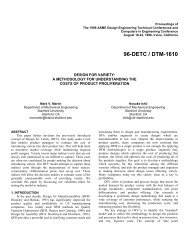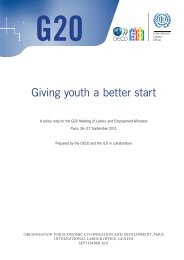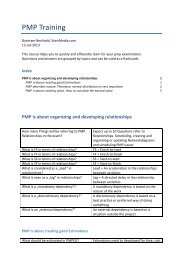Social Marketing
Create successful ePaper yourself
Turn your PDF publications into a flip-book with our unique Google optimized e-Paper software.
Some Determinants that Influence Behaviors<br />
External Determinants<br />
The forces outside the individual that<br />
affect his or her performance of a<br />
behavior.<br />
Skills: the set of abilities necessary to<br />
perform a particular behavior.<br />
Access: encompasses the existence of<br />
services and products, such as helmets<br />
and safety seats, their availability to<br />
an audience and an audience’s comfort<br />
in accessing desired types of products<br />
or using a service.<br />
Policy: laws and regulations that affect<br />
behaviors and access to products and<br />
services. Policies affecting traffic safety<br />
include child seat laws, seat belt laws,<br />
and driving under the influence.<br />
Culture: the set of history, customs,<br />
lifestyles, values and practices within a<br />
self-defined group. May be associated<br />
with ethnicity or with lifestyle, such as<br />
“rural” or “youth” culture.<br />
Actual consequences: what actually<br />
happens after performing a particular<br />
behavior.<br />
Internal Determinants<br />
The forces inside an individual’s head that<br />
affect how he or she thinks or feels about<br />
a behavior.<br />
Knowledge: basic factual knowledge<br />
about traffic safety, how to protect oneself<br />
from injury, where to get services, etc.<br />
Attitudes: a wide-ranging category for what<br />
an individual thinks or feels about a variety<br />
of issues. This over-arching category would<br />
include self-efficacy, perceived risk, and<br />
other attitudinal factors.<br />
Self-efficacy: an individual’s belief that he<br />
or she can do a particular behavior.<br />
Perceived social norms: the perception<br />
that people important to an individual think<br />
that she or he should do the behavior.<br />
Norms have two parts 1) who matters most<br />
to the person on a particular issue, and<br />
2) what she or he perceives those people<br />
think she or he should do.<br />
Perceived consequences: what a person<br />
thinks will happen, either positive or negative,<br />
as a result of performing a behavior<br />
Perceived risk: a person’s perception of<br />
how vulnerable they feel (to crashes, etc).<br />
Intentions: what an individual plans or<br />
projects she or he will do in the future;<br />
commitment to a future act. Future<br />
intention to perform a behavior is highly<br />
associated with actually performing<br />
that behavior.

















